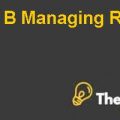
Competitive Landscape
There was a very stiff competition in the cleaning products industry, therefore most of the players were developing new and innovative products to get a competitive advantage over the rest of the industry. These companies were trying to attract customers by diversifying their products and services for example companies like S.C. Johnson had started to offer a highly-concentrated version of their existing offerings, which would allow the customers to re-use their products by simply refilling them with the same solutions. Nilfisk-Advance had focused on the commercial cleaning market and provided services to industrial and institutional customers. It had a strong market position in the production of technologically advanced products i.e. electronic vacuum cleaner. Hako-Werke GmbH was offering environmental friendly, technologically based products and targeted the domestic and industrial markets simultaneously. It was operating in more than 60 countries across the globe with high brand recognition. Apart from these brands there were a number of other highly recognized brands in the high-end market niche i.e. Mr. Clean and Clorox from major corporations such as S.C. Johnson and Proctor & Gamble. These companies were offering their products in the upper class customer segment and had a high market share in the world wide recognized retail channels and supercentres i.e. Target, Wall Mart, etc.…
Collaborator Landscape value chain
The company had developed a number of strong relationships with different buyers and suppliers. With the help of its Orbio technology platform, it had made a number of successful collaborations and strategic partnership with some other players of the industry. It had also negotiated certain healthy terms with some world wide retail stores in order to place their products at premium shelves. These negotiations proved beneficial for the company and a number of retail stores and a large services company had told the CEO of Tennant that they would use the company’s new products on trial basis in their offices and other work premises. This would help the company to test their products in a real working environment and check its efficiency effectively.
Value Chain
The company had very healthy relationships with its suppliers and was striving to establish good relations with distribution and world wide retail channels. The company provided a sustainable value through their products to a number of buyers, including industrial, government and institutional managements. It had developed strong services, structure and facility along with developing a diverse product portfolio. The company had hired and trained its sales force to bring the brand at the top most position of the industry and increased its customer base. It had a very competent human resource team and executives that could make good decisions even under severe pressure conditions.
Situation Analysis - Internal Contextual Factors
Mission & Goals
The company’s core mission was to serve the customers with environmentally friendly and healthy cleaning products with a tag line of “Creating a Cleaner, Safer, Healthier World”. It was providing a wide range of products and services to its customers and tried to change the traditional ways of cleaning floors and clothes by developing certain technologically advanced products. The basic goal of the company was to develop such sort of products that could reduce the hazardous environmental impact and provide a sustainable cleaning experience to the user. It was also trying to increase value for the shareholder, while maintaining a healthy and green product portfolio.
Business Model Strategy
It has been evaluated that the business level strategy of the company was a differentiation strategy because instead of developing and enhancing the technologically based products without reducing the use of chemicals in it; the company had differentiated itself by developing such products that had a negligible use of chemicals and used the ionized tap water for disinfecting and cleaning purpose with a negligible environmental impact. With the help of this product, the company had achieved a sustainable competitive advantage over the rest of the industry and differentiated itself on the basis of new and innovative product offerings.
Performance Gap Analysis
It has been observed that the company was not using its resources effectively because it was one of the oldest companies in the cleaning products industry and had a huge customer base. The company had its presence in the floor-cleaning market segment only, which was not sufficient for attaining a sustainable growth and product portfolio in the market. It had a huge market share and brand recognition, which could give it sustainable growth opportunities in the market but it was unable to make appropriate use of its resources and therefore remained reserved for a single market niche only besides having achieved economies of large scale production...............................
This is just a sample partial case solution. Please place the order on the website to order your own originally done case solution.









